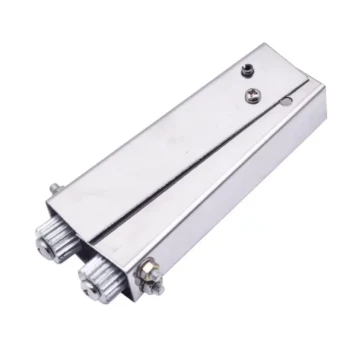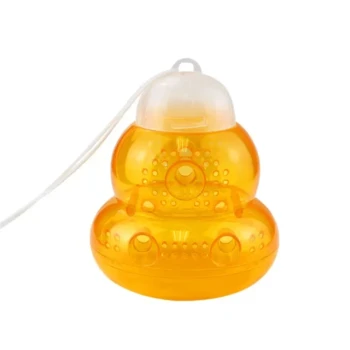When choosing a treatment for Varroa mites, the advantages of oxalic acid over synthetic drugs are significant and center on two key issues: chemical residues and mite resistance. Unlike many synthetic miticides, oxalic acid is an organic compound that does not leave harmful residues in honey or wax. Crucially, Varroa mites have not developed resistance to oxalic acid, a persistent problem that can render synthetic treatments ineffective over time.
Choosing the right Varroa treatment is a decision that impacts not just mite levels, but the long-term health of your colony and the purity of your hive products. Oxalic acid's primary advantage is its ability to sidestep the twin problems of chemical residue and mite resistance that plague many synthetic options.

The Core Problem: Residues and Resistance
The challenge with any pest management strategy is to control the target pest without causing unintended harm. In beekeeping, this means killing Varroa mites without harming bees, contaminating hive products, or creating a more resilient pest.
The Downside of Synthetic Miticides
Synthetic drugs, while effective initially, can leave chemical residues in the wax and honey. These residues can pose risks to human health and compromise the quality of your honey.
Furthermore, repeated use of the same synthetic chemical creates evolutionary pressure on the mite population. Over generations, mites that are naturally more tolerant of the chemical survive and reproduce, leading to a resistant population that no longer responds to the treatment.
How Oxalic Acid Is Different
Oxalic acid is an organic acid पुलिस, naturally found in many plants, including honey itself. When used correctly for mite treatment, it does not accumulate in beeswax or honey, ensuring the purity of your hive products.
It works by direct contact, penetrating the mite's tissues and disrupting its cellular metabolism. To date, this mechanism of action has not appeared to promote resistance in Varroa populations, making it a sustainable long-term tool.
How Oxalic Acid Works in the Hive
Understanding the application and its limitations is key to using oxalic acid safely and effectively. It is a powerful tool, but it is not a "silver bullet" for every situation.
Mechanism of Action
Oxalic acid kills phoretic mites—the mites that are on the bodies of adult bees. It has very limited adverse effects on the bees themselves when the dosage is correct and the application method is appropriate.
Common Application Methods
There are two primary methods for applying oxalic acid:
- The Drip Method: A solution सरकार of sugar syrup and oxalic acid is dripped directly onto the bees clustered between the frames.
- The Vaporization (or Sublimation) Method: A special tool is used to heat crystalline oxalic acid, turning it into a vapor that fills the hive and coats the bees and surfaces.
Understanding the Trade-offs
No treatment είναι perfect, and being aware of oxalic acid's limitations is critical for responsible beekeeping. Its effectiveness is highly dependent on timing and the state of the colony.
It Does Not Kill Mites in Brood Cells
This is the most important limitation. Oxalic acid does not penetrate the wax cappings of brood cells. This means it will not kill mites that are reproducing繁殖 within the capped brood.
Timing and Dosage are Critical
Because it only kills mites on adult bees, oxalic acid is most effective during periods when the colony has little or no brood, such as in late fall, winter, or during a natural nectar dearth.
Using an incorrect dosage or applying it too frequently can harm the bees, particularly the queen and any open brood. Always follow approved guidelines for your region.
It's One Part of a Larger Strategy
For these reasons, oxalic acid is best viewed as a component within a broader Integrated Pest Management (IPM) plan. It is not a standalone solution to be used year-round but rather a specific tool জন্য a specific job, often rotated with other treatments.
Making the Right Choice for Your Apiary
Your decision should be based on a clear understanding of your goals for the health of your bees and the quality of your hive products.
- If your primary focus is producing residue-free honey and wax: Oxalic acid is the superior choice, as it does not contaminate hive products.
- If your primary focus is preventing long-term mite resistance: Integrating oxalic acid into your treatment plan is a critical strategy to ensure your methods remain effective.
- If you need to treat during a heavy brood-rearing period: Be aware that oxalic acid will have limited effect, and you may need to consider other treatment options or repeat the application after the brood has emerged.
Ultimately, understanding how and when to use oxalic acid empowers you to protect your bees effectively while safeguarding the long-term health of your apiary.
Summary Table:
| Feature | Oxalic Acid | Synthetic Drugs |
|---|---|---|
| Chemical Residues | No harmful residues in honey or wax | Can leave chemical residues |
| Mite Resistance | No known resistance developed | Resistance can develop over time |
| Primary Action | Kills phoretic mites on adult bees | Varies by product |
| Brood Cell Penetration | Does not penetrate capped brood | Some products can penetrate brood |
| Ideal Usage | Part of an Integrated Pest Management (IPM) plan | Can become ineffective due to resistance |
Equip Your Apiary for Sustainable, Residue-Free Beekeeping
Choosing the right Varroa control is essential for the health of your bees and the purity of your hive products. At HONESTBEE, we supply commercial apiaries and beekeeping equipment distributors with the high-quality supplies needed to implement effective, sustainable pest management strategies.
Let us help you protect your investment and ensure the long-term health of your colonies. Contact HONESTBEE today to discuss our wholesale-focused offerings and find the right equipment for your integrated pest management plan.
Visual Guide

Related Products
- Adjustable Formic and Acetic Acid Dispenser for Bee Mite Treatment
- Professional Bamboo Queen Isolation Cage
- Varroa Easy Check Mite Tester Kit Counter Alcohol Wash Jar
- HONESTBEE 3-Frame Manual Acrylic Honey Extractor
- HONESTBEE Heavy Duty All Metal Frame Wire Crimper Tool
People Also Ask
- What is the focus of hive management during summer? Maximize Your Honey Harvest with Expert Tips
- What does Chewed Down Brood (CDB) indicate in bee colonies? A Sign of Varroa Mite Infestation
- What is the optimal time for varroa mite control in nucs? Maximize Efficacy with Perfect Timing
- What are phoretic mites? A Beekeeper's Guide to Monitoring Varroa Infestation
- What are the symptoms of Varroa Mite Syndrome (VMS)? Recognizing the Signs of Colony Collapse


















